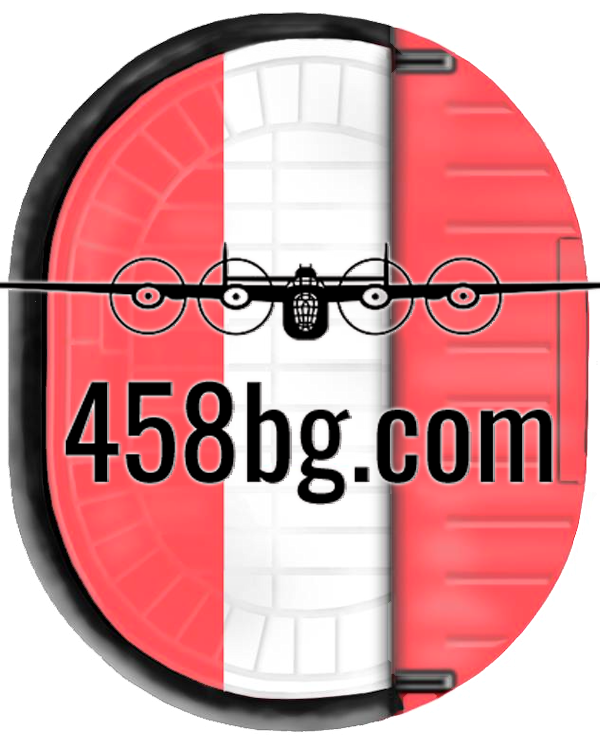Hansen Crew – Assigned 754th Squadron – May 1944
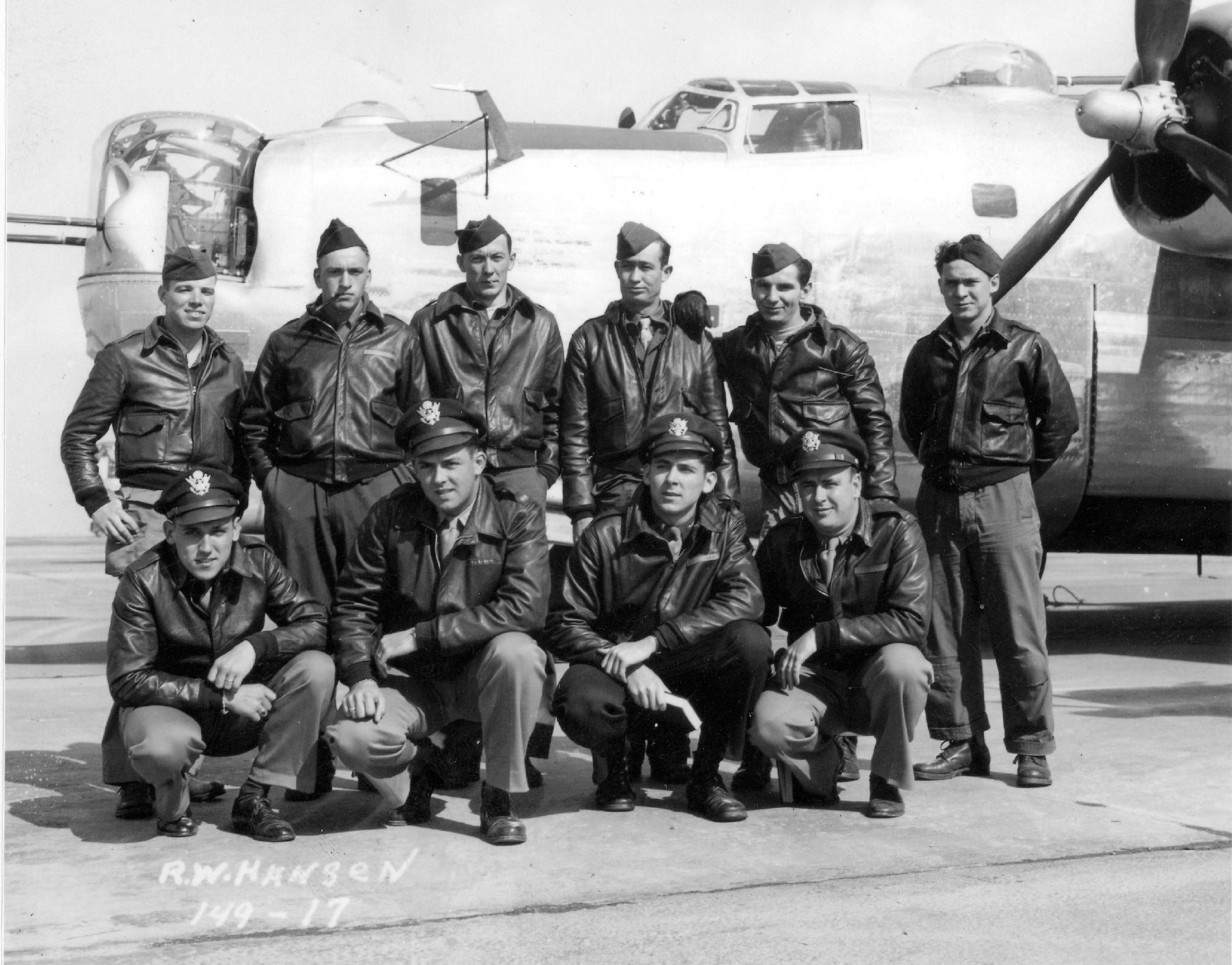
Kneeling: Bob Hansen – P, Bill Fuqua – CP, George Kovaka – N, Wayne Spurgeon – B
Completed Tour
| Rank | Name | Serial # | Crew Position | Date | Status | Comments |
|---|---|---|---|---|---|---|
| Capt | Robert W Hansen | 0693773 | Pilot | Jan-45 | CT | Trsfr to 70CP for return to ZI |
| 2Lt | William J Fuqua | 0817192 | Co-pilot | 23-May-44 | KIA | Mid air collision w/351BG B-17 |
| 1Lt | George A Kovaka, Jr | 0712843 | Navigator | May-45 | CT | Trsfr to 70CP for return to ZI |
| Capt | Wayne L Spurgeon | 0681766 | Bombardier | Mar-45 | CT | Appointed as Sqdn Bombardier |
| T/Sgt | Gavin A Steele | 36443069 | Radio Operator | Jan-45 | CT | Trsfr to 70CP for return to ZI |
| T/Sgt | Irvin R Liverett | 13122313 | Flight Engineer | Jan-45 | CT | Trsfr to 70CP for return to ZI |
| Sgt | Honnie B Gunnoe | 13121271 | Armorer-Gunner | 04-Jul-44 | RFS | Reclassified MOS 912 Electrican, Auto |
| Sgt | Eddie B Hollins | 34651457 | Armorer-Gunner | 04-Jun-44 | RFS | Reclassified MOS 911 Armorer |
| S/Sgt | Al G Seley | 39038638 | Aerial Gunner | Jan-45 | CT | Trsfr to 70CP for return to ZI |
| S/Sgt | George Zevkovich | 35055721 | Aerial Gunner | Jan-45 | CT | Trsfr to 70CP for return to ZI |
2Lt Robert W. Hansen’s crew was assigned to the 754th Squadron in May 1944. On May 19th, Hansen flew his first mission as co-pilot with an experienced crew. He led his crew on their first mission the next day. After flying a number of missions (including leads), they were transferred to the 755th Squadron in December 1944. Most of the crew members completed their tour of combat missions on December 24, 1944 and were homeward bound in January 1945. S/Sgt Honnie B. Gunnoe and S/Sgt Eddie B. Hollins were Removed from Flying Status (RFS) in July 1944 and reclassified – Gunnoe as an Automotive Electrician (MOS 912) and Hollins as an Airplane Armorer (MOS 911).
2Lt William J.R. Fuqua, co-pilot, was assigned to fly with the crew of 1Lt Kenneth C. Barton on May 23, 1944. During assembly, their B-24 collided with a B-17 piloted by 1Lt Peter E. Crowe from the 351st Bomb Group. Both planes broke apart in the air and crashed near Eye in Suffolk. Three men managed to bail out of the B-17, but all those on Barton’s crew were killed.
Capt Wayne Spurgen was appointed Assistant Squadron Bombardier in December 1944, and elevated to Squadron Bombardier in March 1945.
Missions
| Date | Target | 458th Msn | Pilot Msn | Cmd Pilot | Ld | Serial | RCL | Sqdn | A/C Msn | A/C Name | Comments |
|---|---|---|---|---|---|---|---|---|---|---|---|
| 20-May-44 | RHEIMS A/D | 43 | 1 | 41-29596 | R | Z5 | 6 | HELL'S ANGEL'S | ABORT - SORTIE | ||
| 21-May-44 | SIRACOURT | 44 | 2 | 41-29596 | R | Z5 | 7 | HELL'S ANGEL'S | |||
| 23-May-44 | BOURGES | 45 | 3 | HANSEN LIST AS 4th MSN | |||||||
| 25-May-44 | MULHOUSE M/Y | 47 | 4 | 42-50279 | T | Z5 | 14 | ENVY OF 'EM ALL | |||
| 27-May-44 | NEUNKIRCHEN | 48 | 5 | KUHN | D1 | 42-110070 | E | Z5 | 2 | ELMER / LADY LUCK | |
| 28-May-44 | ZEITZ | 49 | 6 | 42-110070 | E | Z5 | 3 | ELMER / LADY LUCK | |||
| 30-May-44 | ZWISCHENAHN A/F | 51 | 7 | 42-110070 | E | Z5 | 4 | ELMER / LADY LUCK | |||
| 31-May-44 | BERTRIX | 52 | 8 | 42-109812 | D | 7V | 22 | UNKNOWN 016 | |||
| 06-Jun-44 | COASTAL AREAS | 56 | 9 | 42-110070 | E | Z5 | 5 | ELMER / LADY LUCK | MSN #1 | ||
| 06-Jun-44 | PONTAUBAULT | 58 | 10 | 42-110070 | E | Z5 | 6 | ELMER / LADY LUCK | MSN #3 | ||
| 11-Jun-44 | BEAUVAIS | 63 | 11 | CHAMBERLAIN | L2 | 42-110070 | E | Z5 | 7 | ELMER / LADY LUCK | WING II GRP B 466 LEAD |
| 12-Jun-44 | EVREUX/FAUVILLE | 64 | 12 | 42-110070 | E | Z5 | 8 | ELMER / LADY LUCK | |||
| 18-Jun-44 | FASSBERG A/D | 69 | 13 | HENSON | L2 | 42-110070 | E | Z5 | 10 | ELMER / LADY LUCK | MSN #1 |
| 21-Jun-44 | BERLIN | 75 | 14 | HENSON | L2 | 42-110070 | E | Z5 | 12 | ELMER / LADY LUCK | |
| 28-Jun-44 | SAARBRUCKEN | 81 | -- | 42-110070 | -- | Z5 | -- | ELMER / LADY LUCK | SPARE LEAD CREW | ||
| 29-Jun-44 | ASCHERSLEBEN | 82 | 15 | WILLIAMSON | L2 | 42-110070 | E | Z5 | 14 | ELMER / LADY LUCK | |
| 07-Jul-44 | LUTZKENDORF | 86 | 16 | FREEMAN | L2 | 42-110070 | E | Z5 | 16 | ELMER / LADY LUCK | |
| 16-Jul-44 | SAARBRUCKEN | 91 | 17 | OLLUM | L1 | 42-50578 | F | Z5 | 2 | SKY ROOM | |
| 19-Jul-44 | KEMPTEN | 94 | 18 | ISBELL | L1 | 42-50578 | F | Z5 | 4 | SKY ROOM | |
| 28-Jul-44 | LEIPHEIM & CREEL A/Fs | SCR | -- | WILLIAMSON | L1 | 42-50578 | F | Z5 | -- | SKY ROOM | BRIEFED AND SCRUBBED |
| 03-Aug-44 | 2 NO BALLS | 102 | 19 | WILLIAMSON | L1 | 42-50578 | A | Z5 | 6 | SKY ROOM | |
| 06-Aug-44 | HAMBURG | 106 | 20 | O'NEILL | L1 | 42-50578 | F | Z5 | 7 | SKY ROOM | |
| 13-Aug-44 | LIEUREY | 112 | 21 | HENSON | L1 | 42-50578 | F | Z5 | 9 | SKY ROOM | |
| 24-Aug-44 | HANNOVER | 117 | 22 | SCHWARTZ | L3 | 42-50578 | F | Z5 | 11 | SKY ROOM | |
| 10-Sep-44 | ULM M/Y | 125 | 23 | SPEER | L1 | 42-50578 | F | Z5 | 13 | SKY ROOM | |
| 23-Sep-44 | HSF to ST DIZIER | TR07 | -- | 42-50349 | X | 44BG | T3 | FLAK MAGNET II | TRUCKIN' MISSION | ||
| 12-Oct-44 | OSNABRUCK | 132 | 24 | SPEER | L1 | 42-50578 | F | Z5 | 14 | SKY ROOM | TYPO AS 587F |
| 17-Oct-44 | COLOGNE | 135 | 25 | SIMES | L5 | 42-50578 | F | Z5 | 15 | SKY ROOM | |
| 02-Nov-44 | BIELEFELD | 140 | 26 | BOOTH | L2 | 42-50578 | H | J3 | 17 | SKY ROOM | |
| 10-Nov-44 | HANAU A/F | 146 | 27 | WAGNER | L | 42-50578 | H | J3 | 19 | SKY ROOM | |
| 04-Dec-44 | BEBRA | 152 | 28 | QUINN | L2 | 44-10602 | P | J3 | 18 | TEN GUN DOTTIE | |
| 24-Dec-44 | SCHONECKEN | 157 | 29 | 42-50499 | U | J3 | 23 | COOKIE/OPEN POST | |||
| 30-Dec-44 | NEUWIED | 161 | ASSY | 41-28697 | Z | Z5 | A40 | SPOTTED APE | ASSEMBLY CREW |
Mid-air collision May 23, 1944

2Lt Robert W. Hansen – Pilot
“I was in the same formation [that day]. It was a terrible situation. I was busy with our own airplane trying to avoid a collision, but I can’t remember to this day how we escaped colliding. I can vividly remember having my windshield full of B-17’s. After we reformed, we knew that one of each aircraft had gone down, but we didn’t know who until we got back on the ground. A week or so after the crash, I understand that “Look” magazine had a picture of two airplanes going down over England, but we never could get a copy of the magazine to find the story behind the picture….
“In checking my log book, I find that we didn’t go on a mission the next day, but flew a local of 5 hours and 30 minutes. If I remember correctly, it was practice bombing on the bomb range near Ipswich because we had been told we were going to be a lead crew and wanted to get some practice for the bombardier. His name was Wayne Spurgeon, and had been a bombardier instructor before he came to our crew. Also on that day, the Squadron Commander and the Operations Officer asked us if we wanted to go to the funeral at the cemetery at Cambridge, but they also advised that they needed crews for the next day. We agreed as a crew that we wanted to go on a mission in remembrance for Bill. From then on I didn’t have a co-pilot, but when we went on a mission as lead, we had a Command Pilot in the right seat. He was the commander of the formation. When we flew local, I never had a co-pilot with me. I often put the bombardier in the right seat because he was a washed out pilot.
“Bill Fuqua was from Trenton, NJ and I did my return processing at Fort Dix, which is close to Trenton. So it was my job to visit his wife and parents to fill in the details. They had convinced themselves that he was probably still alive someplace in Germany, even though the notification stated KIA.
Also, Bill’s wife and my wife had met each other while we were at Topeka for about a week doing final processing and picking up a new airplane to take to England over the North Atlantic. So after she had been notified of Bill’s [being] KIA, she called my wife to find out if my wife (Marion) had heard from me. So that really worried her for several days until she got a letter from me. We used what was called “V” mail those days and mail traveled pretty fast.”
(Bill Fuqua painting courtesy: Peg De Rose)
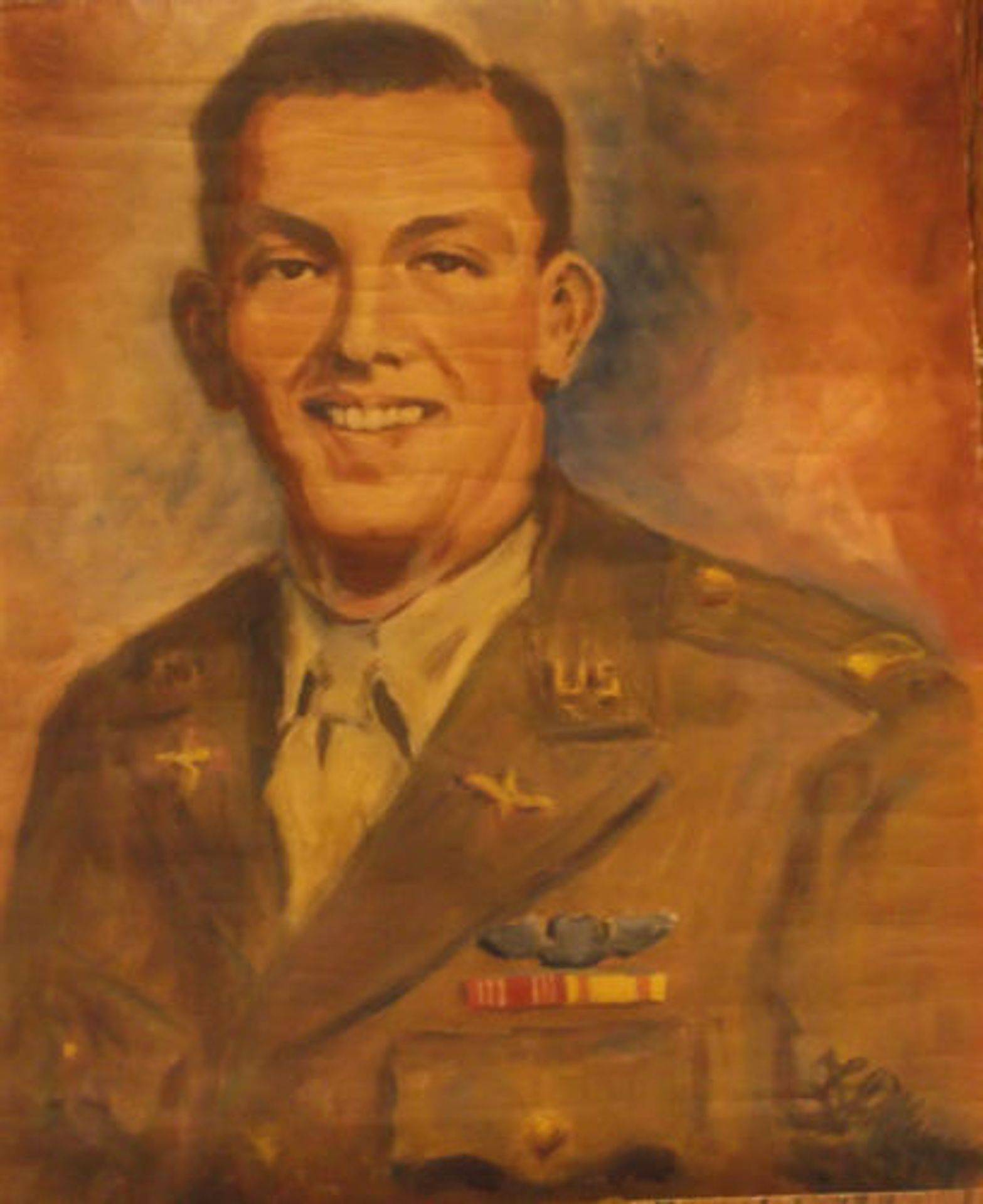
B-24J-1-FO 42-50578 Z5 U Sky Room
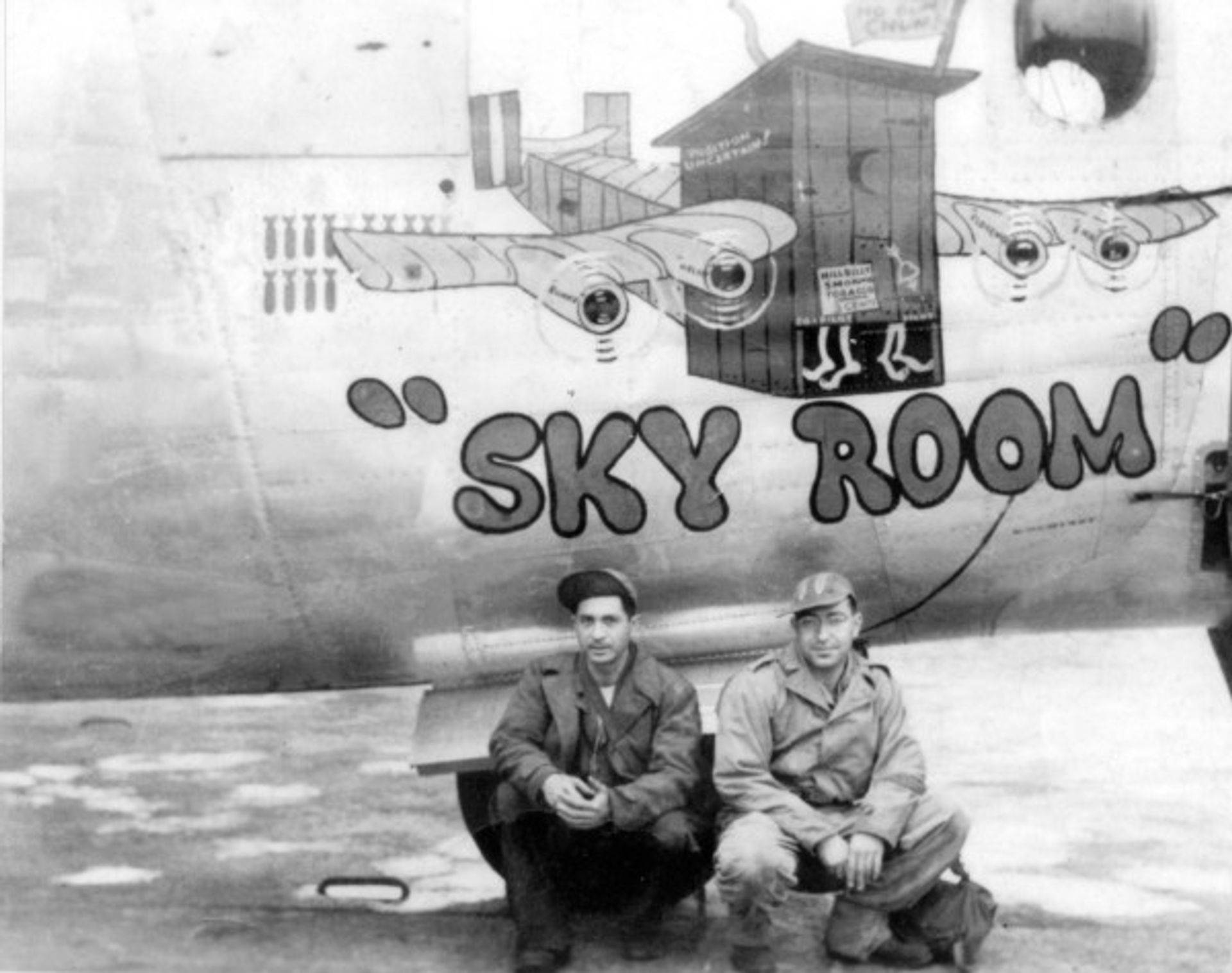
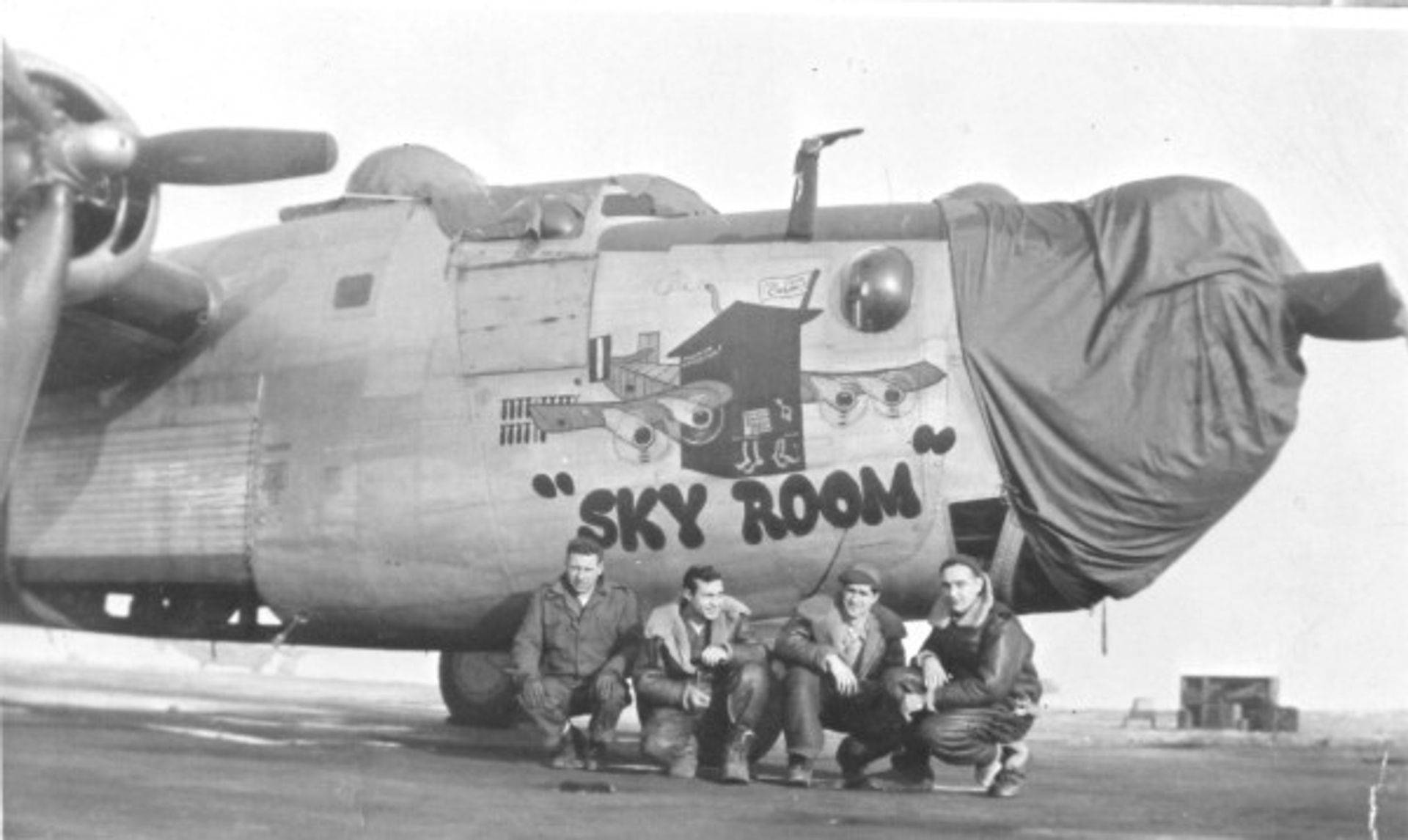
Hansen and crew flew Sky room on 11 missions towards the end of their tour.
(Photos: Bob Hansen & Mike Bailey)
A Journey from Rochester, New York to the Sky Room
Introduction
This monograph is an acknowledgment of the contributions made by a group of people from America who have been called the “Greatest Generation.” Robert Hansen was not quite 20 years old when the Japanese struck at Pearl Harbor. Like many of this era he put his plans on hold to serve in the armed forces. In so doing he embarked upon a journey that would see the advancement of aviation in a few short years.
It was aviation theory that by using airplanes and bombs a nation could be conquered and made to bend to the will of the bombing nation. By using advanced equipment such as “Gee”, a device that required a master station and two slave stations an aircraft could be placed in a geographical area in order to drop bombs on a given target. As the war progressed and the weather in Europe deteriorated other methods had to be used. One example of that was used by the 458th Bomb Group and it was GH aircraft.
GH aircraft used an airborne Gee transmitter and two ground based stations. Since the limit of land based was about 300 miles the airborne transmitter allowed the forces to move into the depths of Germany and gave them the ability to bomb through a thick (10/10ths coverage) undercast and was very accurate. In fact it was superior to H2X, also known as Mickey. This type of bombing was used in support of ground troops after the invasion of Normandy on June 6, 1944.
H2X, known by the British as H2S, is a radar system and it could only locate a target in a general manner such as a large city. The Germans for logistical and technological reasons placed their synthetic oil plants away from urban areas. Therefore they could only be bombed by visual means. So during the winter of 1944/45 the oil plants were bombed on visual days and the cities were bombed with H2X on overcast days. H2X bombing accuracy could be improved if any part of the bombing run was aided by visual identification.
Some of the unit histories note when GH and H2X equipment was used and it is so noted in the missions. However, some formation sections did not have this equipment and it is difficult to note which section Dad was flying.
This highly technical type of warfare began with training and soon our Father was to find himself in the biggest advancement in training concepts the world had ever seen.
———————
Enlistment
Robert W. Hansen enlisted in the United States Army on January 15, 1942. This obviously was just after the United States was attacked by Japan at Pearl Harbor, Territory of Hawaii.
It is useful to remember that the advent of aviation was a new concept and highly technical and with the attack on Pearl Harbor the United States Army realized that training was going to be the key to winning the war. The problem of training was complicated by the highly technical nature of the skills required for the Army Air Forces. In its pamphlet “The Official Guide to the Army Air Forces” AAF by Pocket Book in 1944 training meant a large increase in the technical specialties. For example, in 1941 the AAF trained 7,244 pilots and in 1943 65,797 were trained, a huge increase by any measure.
According to the pamphlet the training program was a continuing experiment in mass education. Originally, it was small, scattered and loosely coordinated and in early 1942 it was unified under two commands, the Technical Training Command and the Flying Training Command. The Technical Training Command leased or bought 452 hotels and turned them into combination barracks and training centers.
During basic training every enlistee learned the skills of a soldier. This training consisted of 73 hours of drill and marches, 15 hours of physical training, 54 hours of marksmanship, 13 hours of military procedure, 8 hours of first aid, 12 hours of sanitation, 3 hours of personal adjustment, 5 hours of care of clothing and equipment, 5 hours of defense against chemical attack, 5 hours of individual security and camouflage, 4 hours of map and photo interpretation, and 4 hours of defense against air attack.
Additionally, individuals headed for aviation cadet training received exhaustive physical, psychological and mental tests for their fitness for the flying program. This testing would also determine which flying specialty a person will attend.
At the time of Pear Harbor Robert Hansen was barely 20 years old but he knew he wanted to fly airplanes. After enlisting in Rochester he was sent to Fort Niagara, New York for about five days. His introduction to the US Army began with shoveling coal. At this time a person could select the branch of the Army and of course he selected the Air Corps. From New York he was sent to Jefferson Barracks, Missouri, just outside of St Louis, for basic training.
From Missouri he went to California and Merced Army Airfield which was a new basic flight training base. At Merced all the tests for Aviation Cadets were taken. These tests included the flight physical, a lengthy written test and then an interview with a board of officers. After this he was sent to the San Antonio Aviation Cadet Center, San Antonio, Texas in November 1942.
The Cadet Center comprised two areas, the first area was for classification and “across the road” was pre-flight and the second area. Dad remembers the term “across the road” was the expression used by everyone at the center.
In the first area tests were administered to classify an individual for which specialized training they would attend. Obviously pilot training was the coveted training specialty and that was what Dad wanted.
Flying training was divided into five distinct phases: Pre-flight School, Primary Flying School, Basic Flying School, Advanced Flying Training, and Transition Flying Training.
Pre-flight School was a 10 week course consisting of: 30 hours of sea and air recognition, 48 hours of Morse code, 24 hours of physics, 20 hours of math, 18 hours of maps and charts and daily military and physical training. Dad remembers having physical training every day and a parade at 4 PM. He also indicates there was some low level hazing between the upper and lower class-men. Individuals had to make square corners when walking and square meals during chow. And of course there was double-time when outside and the favorite military highlight of white glove inspections. He also said there were few eliminations during this phase and soon it was on to the next phase of training.
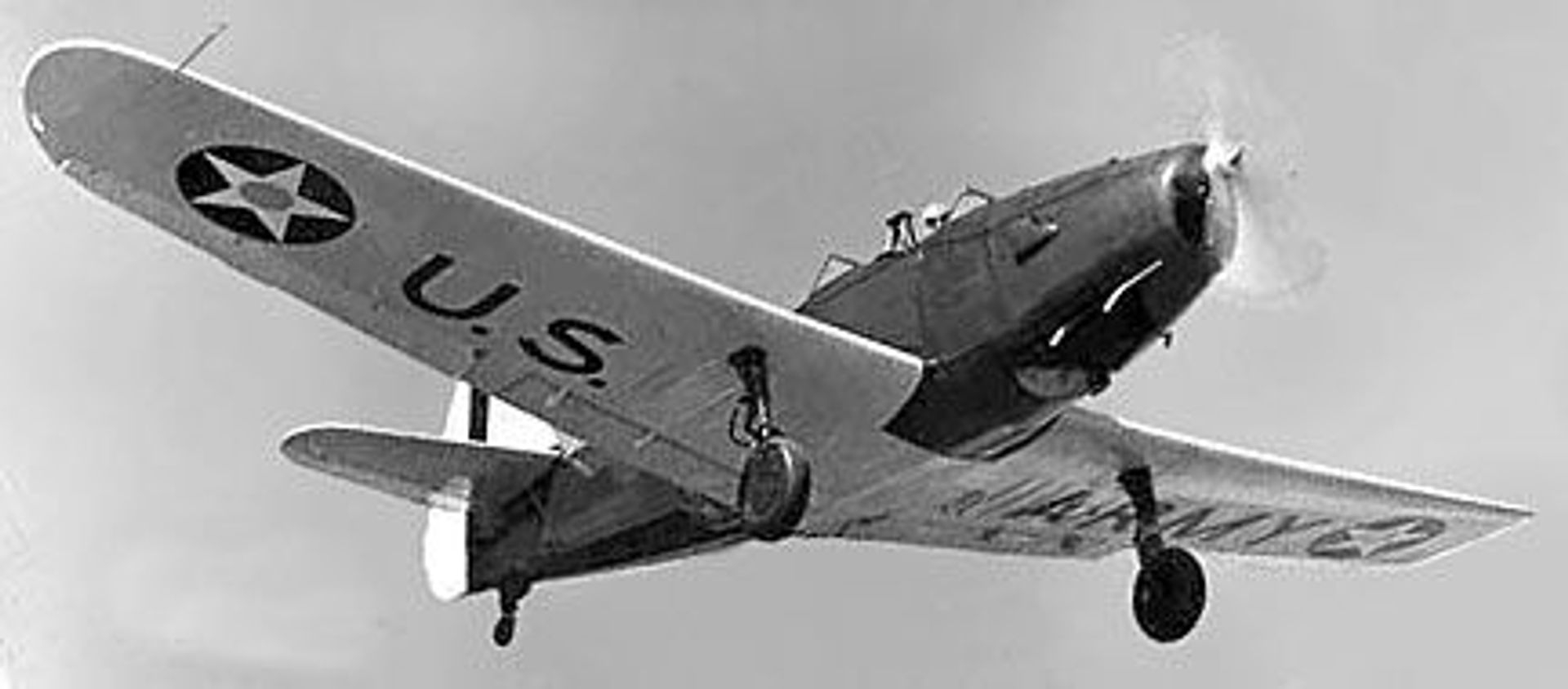
Primary Flying School
The next phase of training was Primary Flying School at Bonham, Texas, which is located approximately 20 miles east of Sherman and south of the Texas-Oklahoma border. This phase was also 10 weeks in length and 70 hours of flight time in a 125-225 horsepower and open cockpit. The airplane could be either a biplane or low wing monoplane. There were 94 hours of academic work and 54 hours of military training. Dad had his first flight on March 23, 1943 in a PT-19A (left). The flight lasted 45 minutes.
Prior to the PT-19A the Army was using either the PT-13 or PT-17. These aircraft were deemed too easy to fly and the PT-19 entered the training program. It had two open cockpits and was powered by Ranger L-440 six cylinder, inverted, air cooled inline engine of 175 horsepower. The aircraft was built by Fairchild and called the Cornell. Over 3,700 of these aircraft were built.
When more orders for the aircraft were made the engine was increased to 200 horsepower. To meet the increasing demand for training aircraft the airplane was also built by Aeronca and St. Louis aircraft companies.
A PT-19B was built to teach instrument flying. A hood was fitted over the front cockpit, which had the instruments for blind flying. Over 910 of the B models were built. Later when a Continental
R-670 radial engine was installed the aircraft was designated a PT-23, a final version was built for the Royal Canadian Air Force with an enclosed cockpit and was designated the PT-26. The aircraft was 27ft 8in long, 36ft wing span and 7ft 7in high. Max takeoff weight was 2,736 with an empty weight of 2,022lbs, max speed of 122 mph, ceiling of 13,000ft and a range of 400 miles.
Dad had his last flight in the PT-19B on May 21, 1943 and finished with a total of 65 hours flight time. His first solo was on April 8, 1943 for a total of 27 minutes and he had two flights in the PT-19B. It was then on to Basic Flying School. Dad survived this portion of training where the washout rate was at least 50%.
Basic Flying School
Basic flying school was at Majors Field, Greenville, Texas, which is about 35 miles northeast of Dallas. Basic was also 10 weeks in length and was in a 450hp basic trainer. The academics consisted of 94 hours in ground school and 47 hours of military training. The object of basic was to teach the cadet to fly the aircraft the Army Air Force way and by the end of training they would be classified as to what type of airplane they were to fly. The classifications were: single engine (fighter), 2 engine (bomber or transport) or 2 engine fighter. The aircraft used was the BT-13.
The Vultee BT-13 Valiant (right) was also known as the Vultee Vibrator. It had retractable landing gear and a powerful engine and was too expensive for the Air Corps of 1938. It was made less complicated by having a fixed landing gear and the Air Corps ordered 300 of the new variants in 1939. It was a tandem cockpit with dual controls and equipped with blind flying instruments. Its most memorable characteristic gave it the nickname of Vultee Vibrator. Production ceased after some 11,500 were built.
The aircraft had a 450hp Pratt & Whitney R-985-AN-1 Wasp Junior radial engine. It was 28ft 10in long, 42ft wing span and 11ft 6in high. Max takeoff weight of 4,496lbs with an empty weight of 3.375lbs, max speed of 180mph, ceiling of 21,650ft and a range of 725 miles.
Dad had his first flight in the BT-13 on May 28, 1943 and first solo on June 4, 1943 for 30 minutes. On June 8th he had his first flight that was an acro training mission. June 22nd was his first cross country mission of one hour and 45 minutes. His first formation was on July 14th. The last flight in the BT-13 was on July 26, 1943. He completed Basic with 92 hours of flight time in the BT-13 of which was 65 hours and 45 minutes of solo time, 14 hours and 10 minutes of instrument and had a total of 11 hours and 45 minutes of Link trainer. Very few of the trainees washed out in this phase.
At this time Dad had some 157 hours of flight time. It was then on to Advanced Training in two engine aircraft and the awarding of his wings.
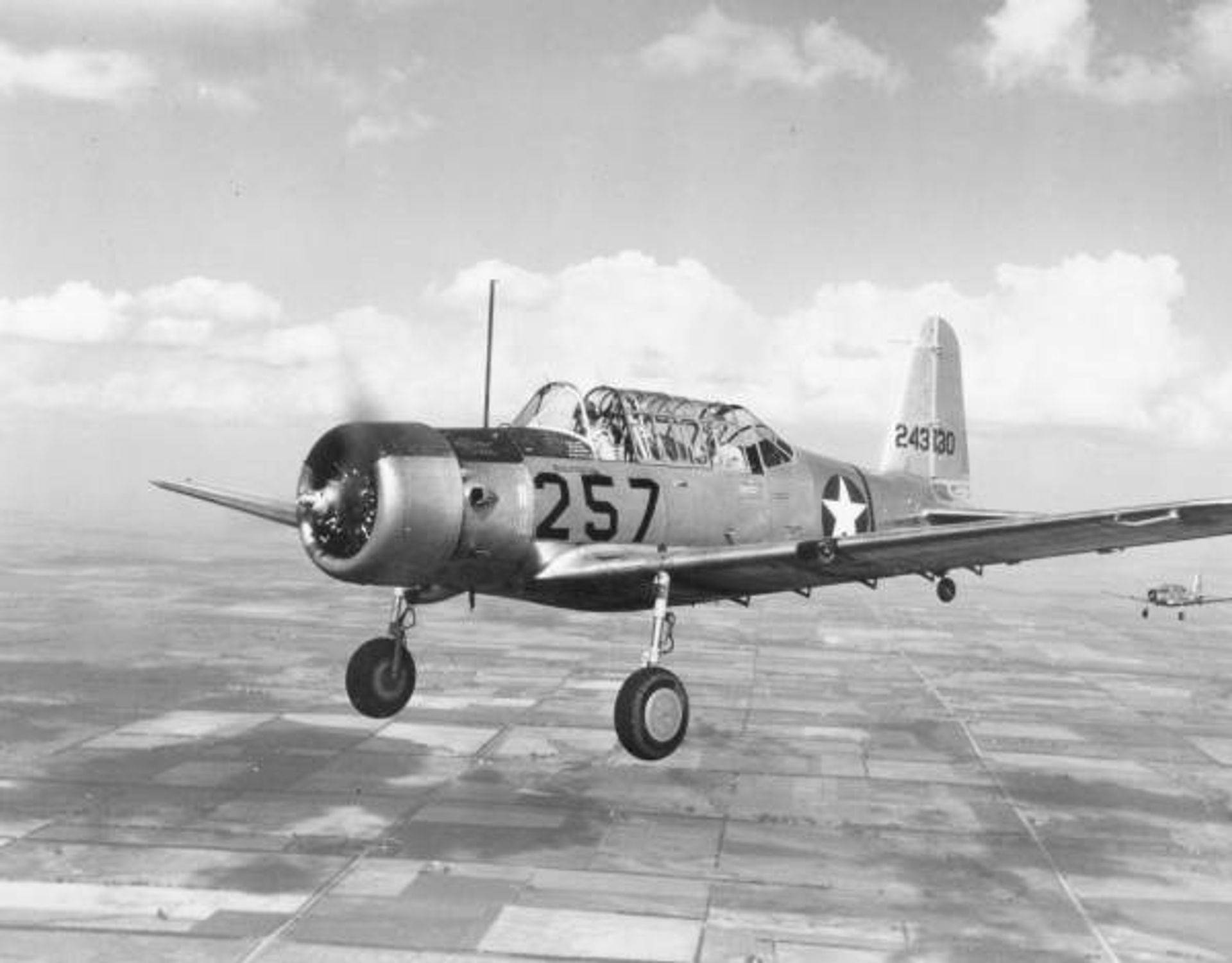
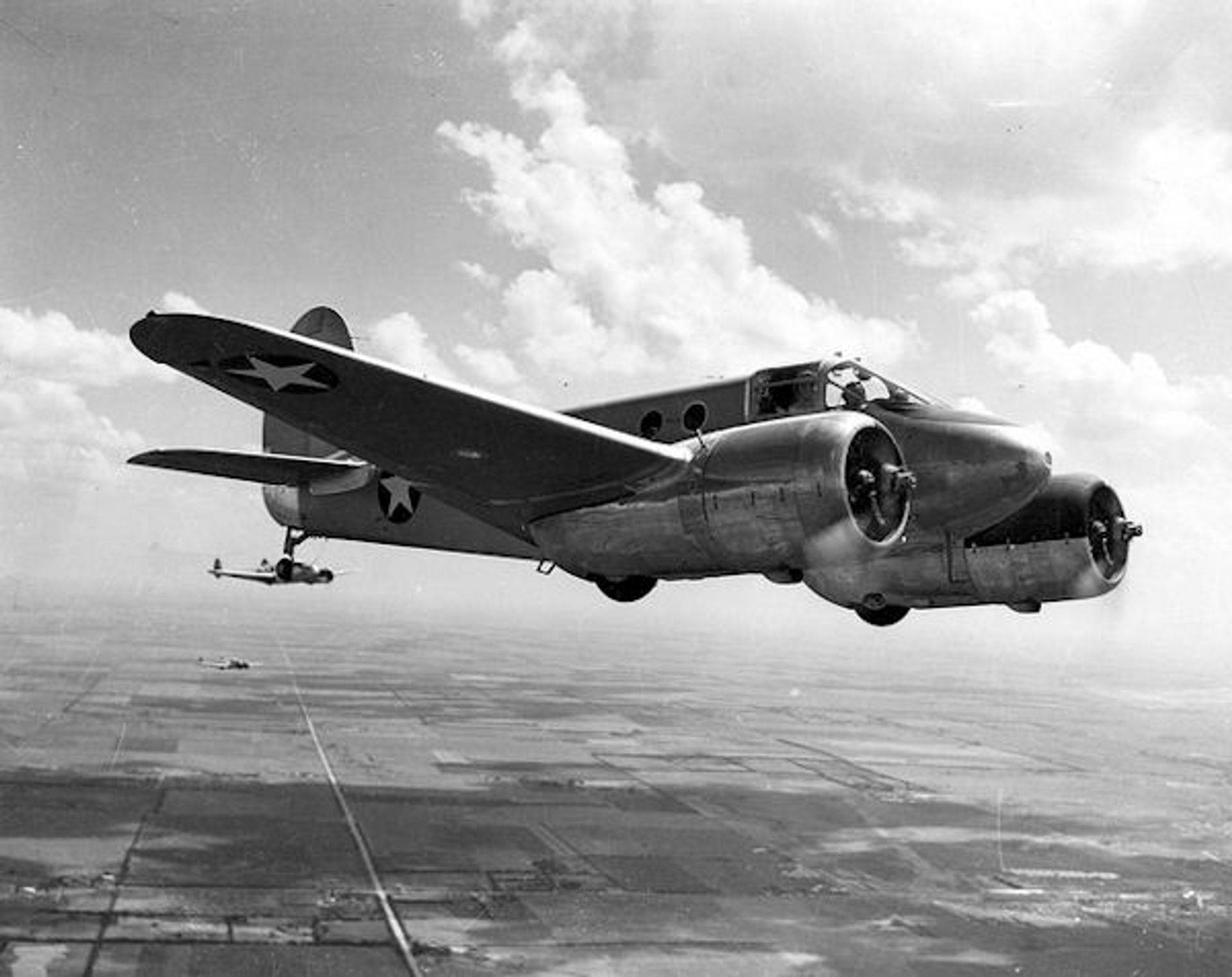
Advanced Flying Training
Dad went from Greenville to Ellington Field, Texas, near Houston. This phase was also 10 weeks long with 70 hours of flying, 60 hours of ground school and 19 hours of military training. Two engine students flew the AT-10 Wichita. Based upon performance students would be designated for either heavy or medium bombers, transport, troop carrier or two engine fighter. At the end students were awarded their silver wings and either commissioned a 2nd Lieutenant or selected as a flight officer.
The AT-10 Wichita (left) was built by the Beech Aircraft Company. The aircraft was built of plywood with only the engine cowlings and the cockpit enclosure built of aluminum. The fuel tanks were also constructed of wood and lined with neoprene. With the use of wood several furniture manufacturers were subcontracted to make many components. Over 1,770 were built by Beech and some 600 were built by Globe Aircraft Corporation.
The aircraft had two Lycoming R-680-9 radial engines with a rating of 295hp each. The AT-10 was 34ft 4in long, 44ft wing span and 10ft 4in high. Max takeoff weight was 6,465lbs with a max speed of 190mph, ceiling of 20,000ft and a range of 660 miles.
Dad’s first flight in the AT-10 was on August 3, 1943. Numerous training missions included cross-country, formation, night flying and instrument missions. The cross-country missions went to such places as Kansas and Iowa. His last mission was on September 30, 1943 and he finished with 77 hours and 50 minutes of flight time. There was also an additional 59 hours and 10 minutes of student copilot time.
After getting his wings and commission on October 1, 1943 Dad went to B-24 Transition Training.
Transition Training
After two weeks of leave Dad went to Liberal Army Air Field, Kansas for this phase of training, arriving there on October 15th. Both B-17 and B-24 pilots were to get 105 hours of flight time and additional ground school in this 10 week course.
The B-24 Liberator was built by Consolidated Aircraft which proposed the Consolidated Model 32 and was awarded the contract on March 30, 1939. Almost nine months later the first flight of the B-24 took place. While the B-24 is slightly smaller than the B-17 it was able to fly farther with a heavier bomb load than the Flying Fortress. It also had a tricycle landing gear as opposed to a tail wheel and a Davis wing, which produced 20% less drag than other wings of its day. The aircraft also had roll up bomb bay doors that reduced drag and allowed the aircraft to continue flying at its cruising airspeed. The airplane had four 1200hp Pratt and Whitney R-1830-65 Twin Wasp turbocharged engines. Gross weight for takeoff as 71,200 lbs for max overload. It had an empty weight of 36,500 lbs and could carry a bomb load of 12,800 lbs. The Liberator was 67’2” long, 110’ wide and 18’ high. It had a max airspeed of 290mph at 25,000’; and a cruising speed of 215mph and a ceiling of 28,000’ and a rage of over 2,100 miles and was equipped with ten 12.7mm machine guns in the nose, upper/ventral ball turrets, a tail turret and two lateral fuselage positions. Over 18,000 B-24s were built compared with just 12,800 B-17s being built. The specifications cited above are for the B-24H/J models.
The first flight in a B-24 was on October 21, 1943. Transition training continued until December 21, 1943. Training ended with almost 64 hours in the B-24 and some 15 hours of Link time.
———————
Replacement Crew Training
Dad then entered replacement crew training at Salt Lake City on Christmas Eve of 1943. There he met his crew and did whatever in-processing was required and then went to Davis Monthan arriving there around January 11, 1944. Replacement training was completed with 140 hours of flying time and some 30 hours in the Link trainer. This training was completed on April 7, 1944. Then it was on to Topeka, Kansas to pick up a new B-24 and depart for Europe.
Of course one of the major events of this time is that Dad married Marion Roelands on February 5, 1944.
Total training time resulted in 498 hours and 40 minutes of flying time from Dad’s entry into Aviation Cadets.
———————
Europe
On April 27, 1944 Dad picked up a brand new B-24H and headed for Manchester, New Hampshire. Total time to Manchester was 9.0 hours. After resting they departed Manchester the following day on April 28 and flew to Goose Bay, Labrador, total flight time of 6.0 hours; then on to Iceland with a total time of 7 hours and 45 minutes. Then after some time in Iceland they departed on May 1, 1944 for Nutts Corner, Ireland and landed there after 5 hours of flight time. After a few hours on the ground they headed for Warton, England where there was a B-24 depot while logging 1 hour and 50 minutes. It was then on to Norwich, England and Horsham Saint Faith Airfield.
Horsham St. Faith is northeast of Norwich, England and was a former Royal Air Force (RAF) installation and inherited by Eighth Air Force. The base had “nice two-story barracks with two to a room…, steam heat…, latrine down the hall…, and the mess hall was on the first floor.” While they did not live in Nissen huts they still managed to complain about the food which basically is the prerogative of every GI.
Horsham St. Faith was the home of the 458th Bombardment Group (Heavy) and they were part of the 2nd Air Division under Eighth Air Force. The group was activated on July 1, 1943 and equipped with B-24 aircraft. They moved to England during January-February 1944 and flew their first missions on February 24, 1944. The group consisted of three squadrons and Dad was a member of the 754th Bombardment Squadron (Heavy).
The 754th was also activated on July 1, 1943 and was re-designated 754th Bombardment Squadron (Very Heavy). Their service in the European Theater of Operations (ETO) was from February 1944 to April 1945 and they served in every major offensive operation.
Walt Disney Productions designed the squadron emblem. It was a medium blue disc with an orange crescent moon through which was a caricatured brown B-24 with yellow eye and horn. It was snorting steam through the nostrils flowing to the tail and terminating in an orange comet formation.
Behind this was a large white cloud formation in the shape of a question mark and on top of this was a jagged yellow lightning flash striking in the direction of the aircraft.
On May 14th & 18th Dad flew two local training missions to acquaint him with the local area.
Combat Mission Number 1-May 19, 1944
On an individual aircraft commander’s first mission he flew as copilot with an experienced crew.
This first mission, on May 19, 1944, went to Brunswick, Germany. Twenty aircraft dropped 200xM17 incendiary bombs with fair results. The formation was attacked by a lone Me-109 and was shot down. Anti-aircraft fire was heavy at the target and resulted in seven aircraft returning with battle damage. Total time logged was seven hours.
Combat Mission Number 2-May 20, 1944
Mission number 2 went to Reims Airfield in France. Dad joined his crew and led them in a formation that consisted of 24 aircraft. The group dropped 240x500GP bombs on the target with excellent results. Assessment showed excellent concentration on hangars on the airfield. No enemy aircraft were encountered and AAA was meager with minor damage to only two aircraft. Total time logged was four hours and 30 minutes.
Combat Mission 3-May 21, 1944
This mission number 3, to Siracourt, France, attacked a “Noball” site, a V-1 launch site, in the Pas-de-Calais area of France. There were 20 aircraft in the formation, which dropped 140x1000GPs with the aid of GH aircraft; no evaluation could be made as they were bombing through a heavy undercast.
There were no enemy aircraft or flak encountered. Total time logged was five hours and 20 minutes.
Combat Mission 4-May 23, 1944
An enemy airfield located in Bourges, France was the target for this mission. It was an assembly plant, operational airfield and airpark all in one. Twenty-nine aircraft dropped 637x250GPs with fair results. No enemy aircraft were encountered. One aircraft was lost due to a B-17 colliding with a B-24 during assembly. Total time logged was seven hours.
Combat Mission 5-May 25, 1944
This mission was into Germany at Mulhouse. The target was a railroad marshalling yard and the formation consisted of 23 aircraft with 230x500GPs. Results were excellent and no enemy aircraft or flak were encountered. Total time logged was seven hours and 30 minutes.
Combat Mission 6-May 27, 1944
The railroad marshalling yard at Neunkirchen, Germany was the target for this mission and it was the first time this target had been attacked. Twenty-four aircraft dropped 208x500GPs with poor results as they landed short of the target from the first section. The second section achieved better results with an excellent pattern. Once again no enemy aircraft or flak were encountered. Two aircraft collided enroute, one crashed and the other aircraft made it back to the base. Another aircraft, tail #946 lost an engine just before the target and they headed for neutral Switzerland and the crew was interned. Total time logged was six hours and forty-five minutes.
Combat Mission 7- May 28, 1944
Once again it was back to Germany at Zeitz to strike an oil refinery. Twenty-six aircraft dropped 1038x250GPs with very good results. No flak or enemy aircraft were encountered. Total time logged was eight hours.
Combat Mission 8-May 30, 1944
This time Zwischenhahn Airfield, Germany was the target. Note: Dad’s logbook noted this target as Oldenburg. The 24 aircraft carried a mixed load of General Purpose and 1B bombs (incendiary bombs). Results were good with many fires caused by the bombing. No enemy aircraft or flak were encountered. Total time logged was five hours and 30 minutes.
Combat Mission 9-May 31, 1944
The target for the last day of the month was a locomotive depot and marshalling yard at Bertrix, Belgium. Due to poor weather the formation was recalled but those aircraft that had crossed into enemy occupied territory received credit for a combat sortie. Total time logged was four hours and fifteen minutes.
Local Missions
In addition to combat missions Dad had to fly local training missions and on the following days in May he did that: 14, 18(2), 22, 24, 29. One mission, on the 18th went to Warton, England which was the B-24 depot.
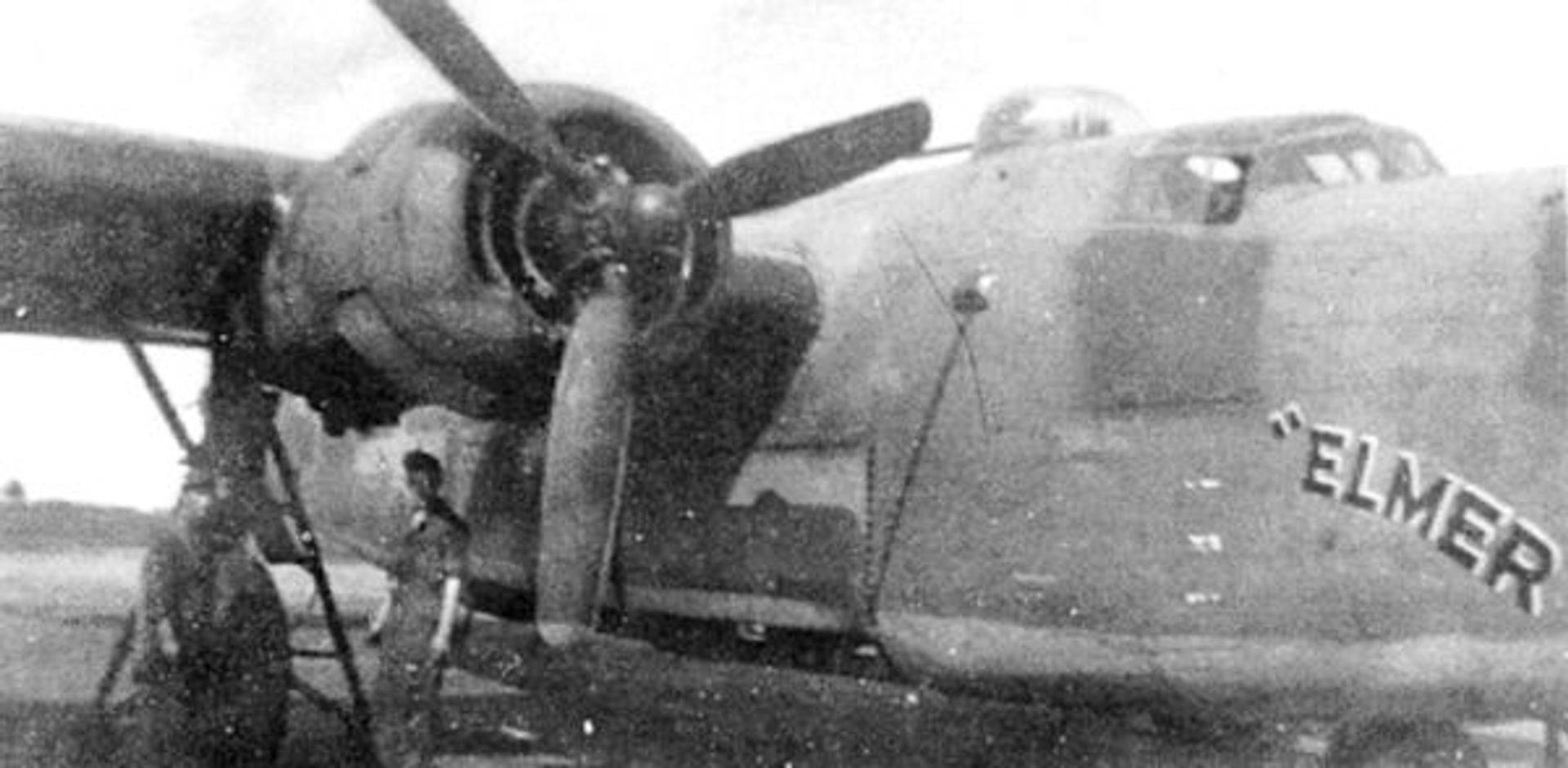
Hansen and crew flew this A/C twice on D-Day, B-24J-130-CO 42-110070 Z5 K Elmer
Combat Mission 10-June 6, 1944 (D-Day)
This day was a day to be remembered in the annals of WWII. Everyone was working on overtime and no one cared, as it was a major push. The first mission was a “Noball” launch site on the coast of France. Thirty-four crews were briefed and the formation was to be a formation of six sections, each consisting of six aircraft each. There is no reason given for the discrepancy between the number of crews briefed and the total needed for the mission, perhaps staff crews were going along on this flight and they did not need to be briefed. Twenty-seven aircraft eventually attacked the target with 65 tons of general- purpose bombs on both the primary and secondary target. Results were not known due to the undercast.
While Dad was bombing the V-1 site another formation supported the Army in the Villers-Bocage area of France, however they did not drop as it was undercast and the local population was mixed in with the defending Germans.
Combat Mission 11-June 6, 1944 (D-Day)
When the first formation arrived back at the base they were fed at the aircraft and quickly interrogated. It was the airplane commanders who were interrogated and then the crews went to the briefing building for the third mission briefing. That mission was Pontaubault and a single line railroad. Eighteen aircraft dropped 216x500GPs with poor results as the main concentration of bombs fell between two highways, two and a half miles southwest of the target. No enemy aircraft or flak were encountered. The group was awarded a Bronze Star for the theater ribbon for participating in D-day operations. Total time logged this day was thirteen hours and forty-five minutes. (Note Dad’s logbook says two “Noball” sites but the unit history says nothing of these sites.) Dad also indicates that during this long day they were given pep pills to stay alert and awake during these missions.
Combat Mission 12-June 11, 1944
Once again the unit was attacking targets that limit the maneuverability of the enemy. An important bridge located at Blois, France was the target for the first section; the second section was to attack an airfield located at Beauvais, Nevilliers, France. Dad attacked the second target with good to excellent results. Nine aircraft attacked this target and dropped 168x250GPs while dropping another 48x250GPs on targets of opportunity. No enemy aircraft were encountered while one aircraft had minor battle damage. Total time logged was five hours.
Combat Mission 13-June 12, 1944
This was one of the largest formations put together by the 458th. Thirty-six aircraft were assigned to attack Evreux/Fauville, France. The object was to keep the Luftwaffe out of the air. Thirty-three attacked the target with 357xM1 incendiary clusters, 24x250GPs with long delay fuses, and 504x250GPs recording excellent results. Once again no enemy aircraft were seen and only three aircraft received minor battle damage. Total time logged was six hours and thirty minutes.
Combat Mission 14-June 18, 1944
This was a two mission day for the group and Dad’s logbook indicates Western Germany as the target. The targets in the unit history notes an airfield at Fassberg, Germany, Bremerhaven and then eight aircraft attacked targets of opportunity. The airfield at Fassberg was not attacked due to undercast conditions. Thirteen aircraft dropped bombs on Bremerhaven via PFF equipment, eight aircraft attacked Heligoland and both were with poor results. One aircraft attacked a marshalling yard at Wrist, Germany and the bombs were noted dropping in the town. Total bombs dropped on these targets were 262x500GPs. One aircraft left the formation, 754th Squadron, with an engine smoking. The second mission attacked a “Noball’” site. Total time logged was seven hours.
Combat Mission 15-June 21, 1944
A big one for today: Berlin. This was the 75th sortie for the group and was to the Genshagen Daimler engine works south of Berlin. Twenty aircraft dropped 168x500GPs on the target with fair results. No enemy aircraft were encountered with this long penetration attack. It is amazing that not one fighter came up to protect the heartland of Germany from this bombardment group. Only one aircraft had minor battle damage. Total time logged was eight hours and thirty minutes.
Combat Mission 16-June 29, 1944
This was the last mission of the month for the group and the target was Aschersleben, Germany, southwest of Magdeburg. The target was the Junkers airframe factory. Nineteen aircraft were over the target with 143x500GPs on the primary and 55x500GPs on a target of opportunity with results ranging from fair to good. Aircraft #008, 754th Sq. failed to return. No enemy aircraft were sighted. Seven aircraft received minor battle damage. Total time logged was seven hours.
Local Missions
Dad flew local training missions on the following dates in the month of June 1944: 1, 2, 15, 17 and 20.
Combat Mission 17-July 7, 1944
Up to this point July was the worst month for weather since the group arrived in the ETO. This mission was a deep penetration raid to the synthetic oil plant at Lutzkendorf, Germany. Twenty-three aircraft were over the target and dropped 223x500GPs visually onto the refinery. Some 25 to 50 enemy aircraft passed under the formation in the vicinity of Bad Frankenhausen, approximately 50 miles west of Leipzig. The enemy formation did not attack the bombers due to the presence of fighter support. An aircraft was lost over the Ruhr Valley on the return leg. Total time logged was seven hours and forty-five minutes.
Combat Mission 18-July 16, 1944
This mission was scheduled for a return raid on the marshalling yard at Saarbrücken, Germany. Twenty-four aircraft dropped 287x500GPs on the target with PFF radar equipment. This bombing was done through a thick undercast with unobserved results. No enemy aircraft were encountered. A barrage of flak was avoided after bombs away and no aircraft sustained battle damage. Total time logged was seven hours.
Combat Mission 19-July 19, 1944
This deep penetration raid went to the Messerschmitt factory at Kempten, Germany, which is approximately 70 miles southwest of Munich. Of the 24 aircraft dispatched 18 bombed the primary target at Kempten. Clouds precluded the evaluation of post strike results. One aircraft bombed Strasbourg, one hit the marshalling yard at Prüm, Germany with unknown results. Intense flak over Stuttgart damaged six aircraft. Total time logged was eight hours.
Local Missions
Local missions were flown by Dad on the following dates in July: 4, 15, 23, 25, and 27.
Combat Mission 20-August 3, 1944
Several “Noball” sites were bombed on this mission. Twenty-two aircraft dropped 478x250GPs with fair results. Total time logged was five hours.
Combat Mission 21-August 6, 1944
Hamburg, Germany and the Rhenania oil refinery was the target for this deep penetration raid. Twenty-one aircraft attacked the target with 264x500GPs with good results. One aircraft from the 755th Bomb Squadron received a direct flak hit during the bomb run. They were flying as the lead section. The direct hit caused the wings to fall off when the aircraft exploded and headed for the ground in flames. Total time logged was six hours and thirty minutes.
Combat Mission 22-August 13, 1944
This mission was to assist ground forces in their attempt to breakout in the Lieusey, France area. Twenty-two aircraft dropped 828x100GPs with good results. Total time logged was five hours.
Combat Mission 23-August 24, 1944
After scrubbing the previous day’s mission the group was briefed on attacking an oil refinery five miles east of the center of Hannover, Germany. Thirty-one aircraft dropped 620x250GPs on the target with excellent results. Total time logged was seven hours.
Local Missions
Local missions flown by Dad were on the following dates in August: 1, 2, 8, 9, 10, 12, 15, 16, 17, 18, 19, 22, and 23. The mission on the 15th is marked as photography. It seems a British officer wanted to take pictures of the towns around Norwich.
Combat Mission 24-September 10, 1944
The major activity for the group in September was to ferry gas to three airfields in France in order to support the advancing ground forces. The first mission for Dad was to the marshalling yard at Ulm, Germany. Nineteen aircraft dropped 90x500GPs and 100×500 M17 incendiaries with PFF. Bombing was done with the aid of PFF and the results were unobserved. Total time logged was eight hours.
Non-operational Status
From 12 September to the end of the month the 458th was tasked to ferry gasoline to France. This operation involved additional work and a lot of it was dangerous, as the 80-octane gas was very flammable. At the start all the aircraft used in the “trucking” operation had four bomb bay platforms on which 218 5- gallon cans were loaded. The aircraft commander was responsible for ensuring the proper loading of this cargo. They figured it would take four hours to load and unload the aircraft. On September 18th the platforms were discarded in favor of fighter drop tanks and the aircraft could carry 1662 gallons of fuel, approximately 11,500 lbs of fuel. British tank trucks brought the gas to the airfield for loading. Aircraft loaded and then took off in three ship formations every ten minutes.
Remember the group had spent some time bombing these airfields that they were now using. This meant the pilots had to be exceptionally careful to stay out of bomb craters and foxholes along with the huge amount of debris. Living conditions at the forward location were much more austere than that back at Horsham St Faith. They lived in tents and ate out of mess kits. They were however rewarded with a tour of Lille, France. This area of the battle was in the control of the British but the “Yanks” were well received by the grateful French. There were many stories of champagne drinking, gifts and souvenirs and of course the French girls.
Each aircraft carried a crew of five, pilot, copilot, navigator, engineer, and radio operator. Each crew member carried their own bedding, rations, canteen of water and a .45 caliber pistol. Takeoff weight was 63,000lbs and a landing weight of 60,060lbs.
A total 494 aircraft were dispatched and 456 arrived at the airfields while transporting some 727,160 gallons of gasoline. Of the 494, six were lost, one crashed on takeoff with the loss of all personnel, one took off and was never heard from again and four were damaged while running into bomb craters on the airfield.
Local Missions
Dad flew local missions for the month of September as follows: 1, 8, 12, 13, 14, 15, and 22. On September 17th Dad flew to Glasgow, Aberdeen and return. On September 23 he flew a “trucking” mission (in the 44BG aircraft pictured at right) to St Dizier, France and returned the next day, September 24.
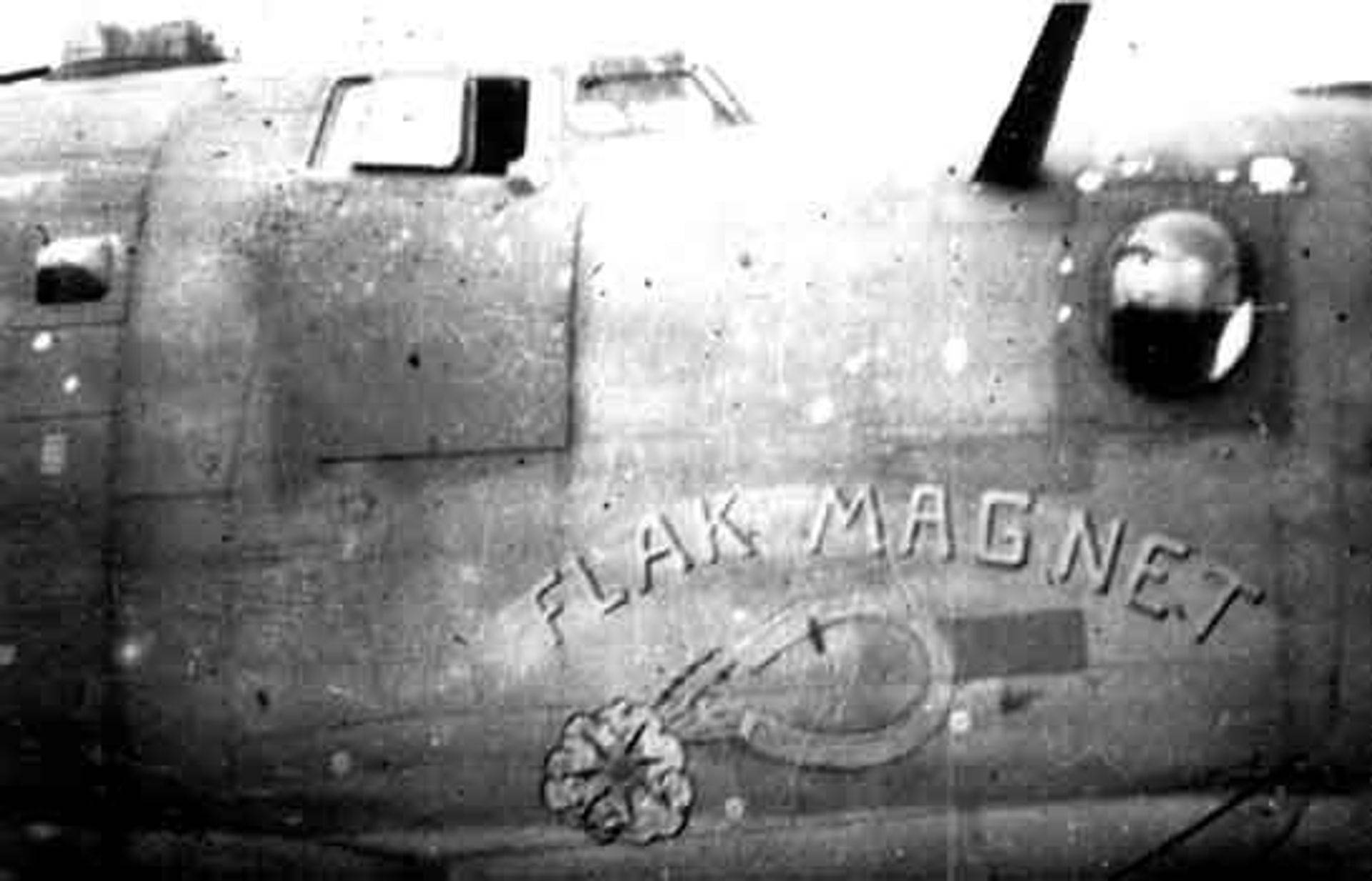
Combat mission 25-October 12, 1944
Once again the weather limited the number of sorties flown during this month. Dad’s first combat sortie in October was to Osnabruck, Germany and its marshalling yards. Twenty aircraft were dispatched and nine aircraft bombed on PFF, the other 11 aircraft could not bomb due to the undercast. A total of 466x100GPs were dropped on this raid. Total time logged was five hours and fifteen minutes.
Combat Mission 26-October 17, 1944
This mission was a raid to Cologne (Köln) and the marshalling yard. Thirty aircraft bombed with the aid of PFF while dropping 189x500GPs and 180 M17s and the results were unobserved. Total time logged was six hours and fifty minutes.
Local Missions
Local missions flown by Dad were on these days in October: 8, 10, 15, 16, 18, 25, 30, and 31.
Combat Mission 27-November 2, 1944
The month of November starts with the hope that the weather remains good in order to make the final push to Berlin. This mission was to Bielefeld, Germany to strike a railroad intersection that linked major cities of Germany. Thirty aircraft dropped 456x250GPs and 112xM17 incendiaries. However, the lead ship dropped prematurely and the rest of the formation dropped on his release and their bombs struck a canal. No flak or enemy aircraft were encountered. Total time logged was six hours and fifteen minutes.
Combat Mission 28-November 10, 1944
The type of mission changed on this day, as the group was directed to hit a German airfield three miles northeast of Hanau. The plan was to neutralize the German effort to use aircraft to strike our ground troops. Twenty-eight aircraft dropped 1003x100GPs on the airfield with the help of GH. Results were unobservable. No flak or enemy aircraft were seen. Total time logged was seven hours and thirty minutes.
Local Missions
Dad flew local missions on these days in November: 1, 8, 21, 26, 27, 29, and 30.
Combat Mission 29-December 4, 1944
Weather again curtailed the missions in this month but with the German offensive it was imperative that the group get airborne. This mission was to the marshalling yard at Bebra, Germany, which is approximately 20 miles southeast of Kassel. Eighteen aircraft dropped 177x500GPs and 32xM17s. The drop was made with GH equipment due to the undercast and results were unobserved. Total time logged was seven hours and thirty minutes.
Combat Mission 30-December 24, 1944 (The last one)
This day started with the comments of good weather for a few days “…so lets go get them.” With the number of down days allowing for maintenance the group was able to put 59 aircraft into one formation, a record for this group up to this time. The mission was to Schönecken, Germany and was to batter enemy transportation, troops, supplies and to demolish storage facilities, crater roads and attack troops in towns. The formation attacked different towns, railroad intersections and railroad centers. Most of the results were good. One aircraft was struck by flak and had the tail section blown off, no survivors were noticed exiting the falling aircraft. Total time logged was six hours and fifteen minutes. This completed Dad’s combat missions and he was to return to the states in a short period of time.
Local Missions
Local missions flown by Dad were on the following dates in December: 1, 2, 3, 15, and 30.
Local Area Highlights and Other Stories
Horsham St. Faith had been an RAF base prior to the arrival of the Yanks and it was a better facility than others. In fact there was an Officers Club, Enlisted Men’s Club, and an American Red Cross facility. There were dances, entertainment and excursions to the local environs of Norwich.
However, it was noted that the Lido Ball Room in Norwich was placed on the “Out of Bounds” list so one can only wonder what caused that to take place. In one piece of unit history the lady that ran the Red Cross facility was having an evening dance when the MPs showed up to tell her that the base had women all over it. They were in the hangars and in the airplanes, who with whom is not indicated, and the MPs wanted this stopped. The Red Cross lady, Sally and her assistant, Miss Audrey Bibby, could do nothing but noted MPs were now stationed at the doors to stop the wandering. The unit history also noted that Miss Bibby’s personality and good looks would enliven the activities at the Red Cross facility, called the Aero Club.
Services provided the troops with movies and entertainment. There were also baseball and basketball teams. Some times there were group discussions about such things as democracy and trips to the local area. The enlisted men began their club and inside of it was a 20’ bar that could accommodate a lot of people. They were all amazed by the ingenuity of one Sgt. Maxwell, know as Max, as he was able to obtain all manner of items such as a seemingly unlimited amount of beer despite it being rationed in England. The troops also entertained local area children during the holidays.
Dad tells several stories of his own. He had a navigator who fell in love with and wanted to marry every girl he came across. The navigator even purchased a ring for one but the rest of the crew took the ring back to the jeweler and got his money returned. There was also the one time Dad flew with someone from the staff and all this staff pilot could do during the flight was stay bent over so he could be protected by the armor plating around the cockpit. A tragic story was when his copilot went to fly with another crew and was killed when the aircraft he was in was run into by a B-17.
On December 4, 1944 Dad was transferred into the 755th Bombardment Squadron (Heavy). By January 1945 he was headed home and to the safety of the United States.
Post War
Dad left the service and went to work in Rochester and took up life at 50 Lodge Drive, Rochester, New York. During the Korean Conflict he was recalled into the Air Force and remained there until his retirement in 1977. He finished with 30 years of service and over 10,000 hours of flying time.
1Lt George A. Kovaka, Jr – Navigator

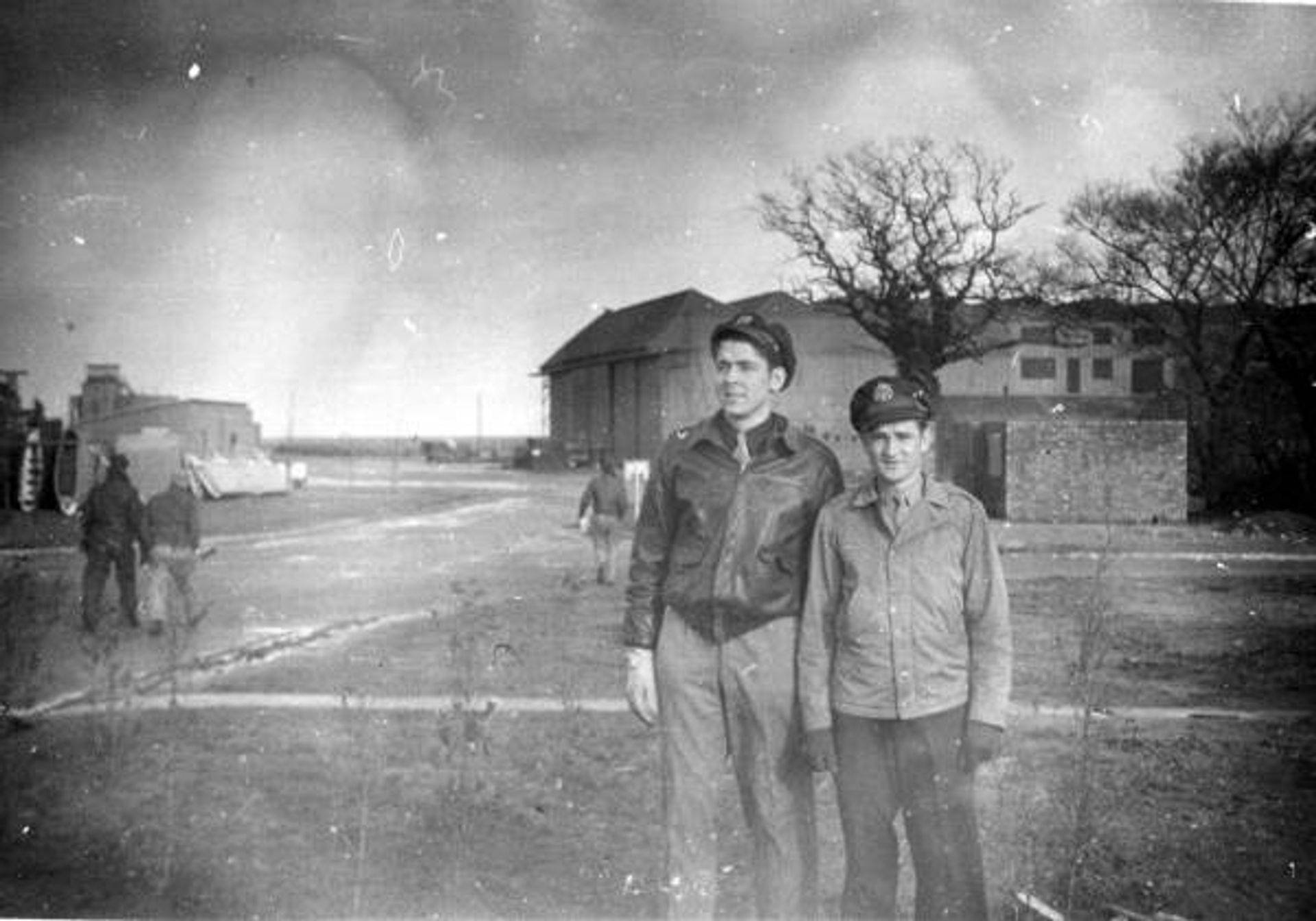
Above: George Kovaka (left) in the hangar area with an unknown officer
Left: Outside of the barracks
(Courtesy: Daniel Kovaka)
